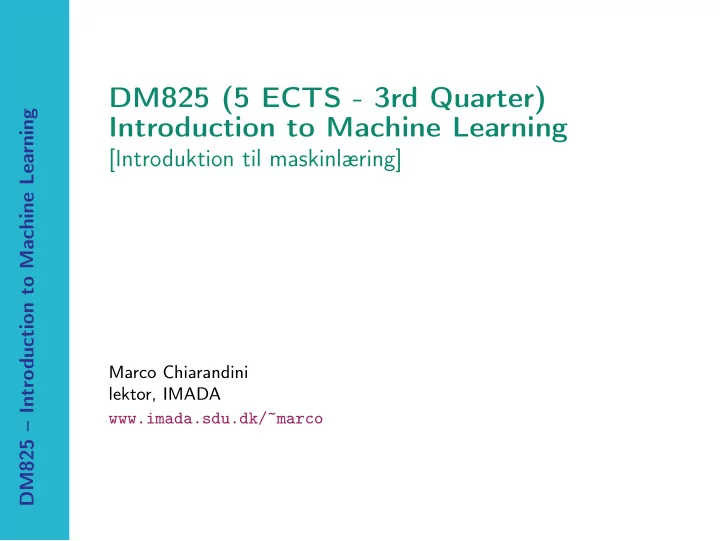

DM825 (5 ECTS - 3rd Quarter) DM825 – Introduction to Machine Learning Introduction to Machine Learning [Introduktion til maskinlæring] Marco Chiarandini lektor, IMADA www.imada.sdu.dk/~marco
Machine Learning Machine learning is the science of getting computers to act without DM825 – Introduction to Machine Learning being explicitly programmed. Application examples: ◮ practical speech recognition and automatic machine translation ◮ effective web search ◮ email spam detection ◮ social networks recognize friends from photos or suggest friends ◮ understanding of the human genome ◮ ... The course focuses on the theoretical background and the practical application of a varied group of techniques.
Contents DM825 – Introduction to Machine Learning ◮ Supervised Learning ◮ Classification and Regression via Linear Models ◮ Neural Networks ◮ Support Vector Machines ◮ Probabilistic Graphical Models Bayesian Networks, Hidden Markov Models ◮ Assessment and Selection ◮ Unsupervised Learning ◮ Mixture Models and Expectation Maximization ◮ Association rules, cluster analysis, principal components, frequent pattern mining
Example: Medical diagnosis ◮ two diseases: Flu and Hayfever DM825 – Introduction to Machine Learning ◮ they are not mutually exclusive ◮ season might be correlated with them ◮ symptoms such as Congestion and Muscle Pain Interrelated aspects of the system are modeled as random variables: Flu = { true , false } Hayfever = { true , false } 2 × 2 × 4 × 2 × 2 = 64 Season = { fall , winter , spring , summer } possible prob. values Congestion = { true , false } for joint distribution MusclePain = { true , false } P ( Flu = true | Seas . = fall , Cong . = true , MusclePain = false ) =?
Graphical Models Encode uncertainty and our prior knowledge in a graphical model DM825 – Introduction to Machine Learning Season Hayfever Flu Congestion MusclePain F and H independent given Season C and S independent given F and H We thus only need to define M and H,C independent given F 3 + 4 + 4 + 4 + 2 = 17 parameters M and C independent given F P ( S , F , H , C , M ) = P ( S ) P ( F | S ) P ( H | S ) P ( C | F , H ) P ( M | F )
Learning What can we do from here? DM825 – Introduction to Machine Learning ◮ Inference: Complexity issues O ( 2 n ) ◮ Learning (parameters and structure) Learning Example: Coin Experiment Flip coin and observe the number of times it lands with head and tail. We wish to learn how much the probability deviates from 0 . 5. Suppose we observe 3 heads in 10 tosses. ◮ With no prior knowledge we would set p = 3 / 10 = 0 . 33 ◮ With a prior of 10 heads over 20 tosses we would set p = ( 3 + 10 ) / ( 10 + 20 ) = 13 / 30 = 0 . 43 ◮ However if we obtain more data the effect diminishes: ( 300 + 10 ) / ( 1000 + 20 ) = 0 . 3 ( 300 + 1 ) / ( 1000 + 2 ) = 0 . 3.
Aims of the Course DM825 – Introduction to Machine Learning After the course you should be able to: ◮ recognize which learning method is suitable for a given task ◮ describe the theory behind the methods ◮ apply the method to example problems with few data ◮ undertake an experimental assessment of learning methods and report the results
Course Information (1/2) DM825 – Introduction to Machine Learning Prerequisites: ❉ DM527 Mathematical Tools, ❉ MM501/MM502 Calculus I and II, ❉ DM502/DM503 Programming A and B, ❉ MM505 Linear algebra – ST501/ST502 Science Statistics/Statistical Modeling are an asset Evaluation: (a) Two mandatory assignments, pass/fail, internal evaluation by the teacher. Applied character, include programming work (in R) (b) 3 hours written exam, Danish 7-point grading scale, External censorship.
Course Information (2/2) Format: 2 × 2h per week=28h lectures + 8/10h exercises DM825 – Introduction to Machine Learning Language: English Material: ◮ No text book ◮ M.C. Bishop, Pattern Recognition and Machine Learning 1st ed. 2006. Springer. 305 pp. ◮ Andrew Ng. Lecture Notes. cs229.standford.edu/materials.html ◮ Lecture notes in form of slides ◮ Articles Credits & Term: 5 ECTS, 3rd Quarter
DM825 (5 ECTS - 3rd Quarter) DM825 – Introduction to Machine Learning Introduction to Machine Learning [Introduktion til maskinlæring] Marco Chiarandini lektor, IMADA www.imada.sdu.dk/~marco
Recommend
More recommend